Orange Farming Information Guide:
The following article is about Orange Farming Practices, and Techniques.
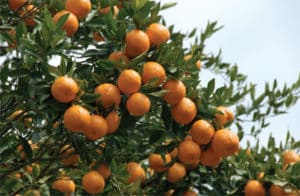
Little about of Oranges:
Mandarin orange (Citrus reticulata) is most common among citrus fruits grown in India. It occupies nearly 40% of the total area under citrus cultivation in India. The most important commercial citrus species in India are the mandarin (Citrus reticulata), sweet orange (Citrus sinensis), and acid lime (Citrus aurantifolia) sharing 41, 23, and 23 % respectively of all citrus fruits produced in the country.
Oranges are mostly grown in the states of Maharashtra, Madhya Pradesh, Tamil Nadu, Assam, Orissa, West Bengal, Rajasthan, Nagaland, Mizoram, Arunachal Pradesh. Orange is rich in vitamin C, A, B, and phosphorus. Orange is consumed fresh or in the form of juice, jam, squash, and syrup. It is the main source of peel oil, citric acid, and cosmetics which have international market value.
Nagpur mandarin is one of the best mandarins in the world. Production of this fruit crop in the central and western parts of India is increasing every year. Mrig crop (monsoon blossom) which matures in February-March has great potential for export since arrivals of mandarin fruit in the international market are very less during this period. Selection of desired quality fruit as per specific market demand and careful post-harvest handling to retain most of natural qualities and freshness plays a key role in expanding exports of Nagpur mandarin (Santra).
Agro-Climatic requirements for Orange Plantation:
Mandarins grow successfully in all frost-free tropical and sub-tropical regions up to 1,500 meters above m.s.l. Annual rainfall of 100-120 cm. and temperature ranging from 10°C-35°C is suitable for the cultivation of the crop.
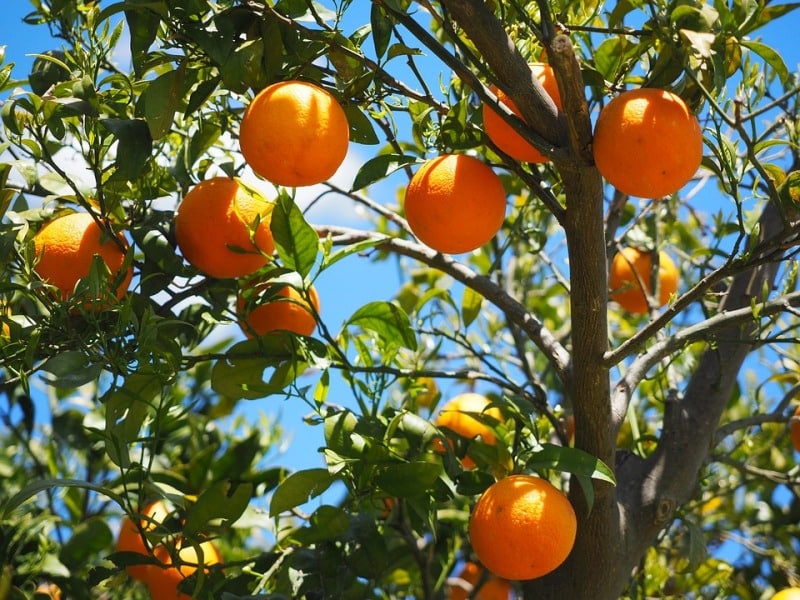
Read this: Profits in Watermelon Farming, Yield per Acre.
Suitable Soil for Orange Plants:
Mandarins are grown in a wide range of soils ranging from sandy loam or alluvial soils of north India to clay loam or deep clay loam or lateritic/acidic soils in the Deccan plateau and north-eastern hills. Citrus orchards flourish well in light soils with good drainage properties. Deep soils with a pH range of 5.5 to 7.5 are considered ideal. However, they can also be grown in a pH range of 4.0 to 9.0. High calcium carbonate concentration in the feeder root zone may adversely affect growth. It is advised that soil tests should be done before getting into orange farming.

Growing and Potential Belts of Oranges:
Nagpur Santra (mandarin) is chiefly grown in Satpura hills (Vidharba region) of Central India, hilly slopes of Darjeeling (West Bengal), and Coorg (Karnataka). In South India, Wynad, Nilgiri, Palney and Shevroy hills are the major mandarin growing belts while hills of Meghalaya (Khasi, Dusha, Garo, Jaintia), Mizoram, Tripura, Sikkim, and Arunachal Pradesh have predominance in mandarins. In Assam, Brahmaputra valley and Dibrugarh districts are famous for mandarin production.
Orange Varieties:
Important mandarin orange varieties cultivated in India are Nagpur Santra, Coorg Santra, Khasi Santra, Mudkhed, Shringar, Butwal, Dancy, Kara (Abohar), SZ-IN-COM, Darjeeling Mandarin, Sumithra mandarin, Seedless-182, and Kinnow mandarin.
Land preparation in Orange Plantation:
The land needs to be thoroughly plowed and levelled. In hilly areas, planting is done on terraces against the slopes and on such lands, high-density planting is possible as more aerial space is available than in flatlands. Since citrus trees are highly sensitive to waterlogging and water stagnation during the rainy season providing drainage channels of 3-4 feet depth along the slopes around the orchard is essential.
Read this: Lemon Tree Grafting.
Planting Material and Planting season for Oranges:
Mandarin orange is propagated by seeds and also vegetatively propagated by T-budding. Seedlings are mostly transplanted in the month of July-August after the commencement of monsoon. Budding should preferably be done in last week of January or first week of February following the ‘T’ or shield budding method.
Orange Plant Spacing Requirement:
Mandarins are usually planted in pits of 50 cm X 50 cm X 50 cm. size in a square system with a spacing of 4.5 meters to 6 meters accommodating 350-450 plants/ha. In north-eastern parts of India, Khasi mandarins are very closely spaced (4.5 m X 4.5 m.), accommodating more than 500 plants/ha. However, a spacing of 6 m x 6 m. accommodating 120 plants/acre has been considered for the present model.
Irrigation supply for Orange Plants:
Requires critical stage watering in the initial year. It further reduces fruit drop and increases the fruit size. Diseases like root rot and collar rot occur in flooded conditions. Light irrigation with high frequency is beneficial. Irrigation water containing more than 1000 ppm salts is injurious. The quantity of water and frequency of irrigation depends on the soil texture and growth stage. Micro-irrigation systems not only save water and nutrients but also ensure good retention of fruits during crucial stages of crop growth in March – April even in situations where water is not a limitation. Water requirement of citrus trees is generally higher than most of the other sub-tropical fruits due to recurrent growth and development. The water requirement varies from 900 to 1100 mm. per year depending upon the location. Water requirement of young (1-4 years old), middle (5-8 years old) and mature (9 and more) Nagpur mandarin trees vary from 5 to 15 liters/day, 35 to 105 liters/day and 60 to 170 liters/day respectively.
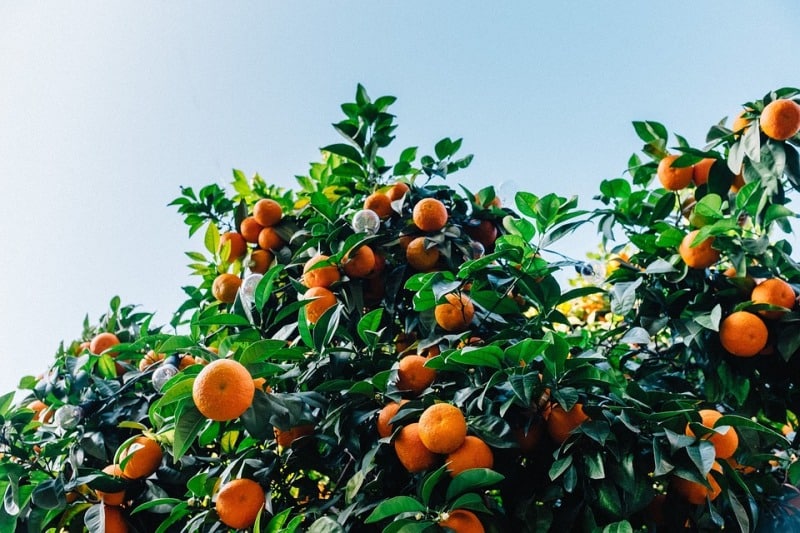
Read this: Layer Poultry Training In India.
Nutritional Requirement of Orange Plants:
The recommended fertilizer dose in terms of N, P & K is given in the following table :
| Age of the plant | Year-wise fertilizer applied (g./plant) | ||
| N | P | K | |
| 1 | 150 | 50 | 25 |
| 2 | 300 | 100 | 50 |
| 3 | 450 | 150 | 75 |
| 4 & above | 600 | 200 | 100 |
About one-third of the recommended dose of nitrogen should be applied through organic manures like farmyard manure (FYM), cakes, etc. In case of non-bearing trees, nitrogen should be applied in split doses during April, August, and November; phosphorus in August and November and potassium in November. Nitrogen should be applied in three split doses in case of bearing trees during April, August, and November along with 200 g. phosphorus in two split doses in August and November and 100 g. potassium in November for mandarin grown in black clay soil.
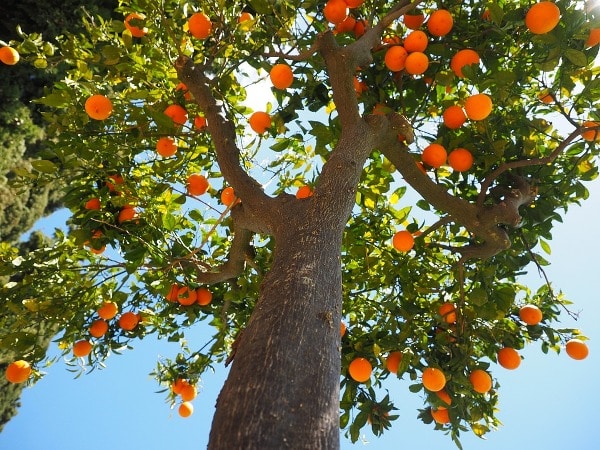
Micronutrients Requirement of Orange Trees:
Micronutrients viz. zinc, copper, manganese, iron, boron, and molybdenum are required in ample quantities. Improper supply of nutrients may cause serious disorders which may lead to the decline of the whole orchard. The micro-nutrients should be supplied through foliar spraying.
Intercultural activity in Orange Garden:
Plowing, spading of basins, weed control, etc., are important inter-culture operations for soil aeration and health. Chemical control of weeds with pre-emergence weedicides like diuron (3 Kg/ha), simazine (4 Kg/ha), glyphosate 4 l/ha, paraquat (2 l/ha), etc. may also be adopted.
Inter-cultivation in Orange Orchard:
Leguminous crops like soybean, gram, groundnut, cowpeas, french bean, peas, etc., may be grown in citrus orchards. Intercropping is advisable during the initial three-four years after planting.
Training and Pruning of Orange Trees:
In order to allow the growth of a strong trunk, initially shoots up to 40-50 cm from the ground level should be removed. The center of the plant should remain open. Branches should be well distributed to all sides. Cross twigs and water suckers are to be removed early. The bearing trees require little or no pruning. All diseased, injured and drooping branches and deadwood are to be removed periodically.
Read this: Spirulina Training In India.
Insect Pests of Oranges:
Devitalization of plants due to poor fruit set, fruit drop both at bearing and maturity stage, stem tunnelling, bark removal, girdling etc., on account of the attack of the different insect pests viz. citrus black fly, citrus psylla, citrus leafminer, bark eating caterpillar, mealy bugs, citrus aphids, citrus thrips, fruit fly, mites etc. results in poor performance by the tree in terms of quality fruit production. Spraying with insecticides viz. monocrotophos, phosalone, dimethoate, phosphamidon, quinalphos, etc. depending upon the type of pest infestation has been found to be effective in most cases.
Diseases of Orange Plants:
The main diseases reported are twig blight, gummosis, damping-off, root and collar rot. The affected plants should be sprayed with Ridomil MZ 72, Bavistin, Benomyl, etc. depending on the type of infection.
Mulching of Orange Plants:
An application of dry leaf mulch or paddy husk to a thickness of about 8 cm. in the basin keeps down the weed growth and decreases the number of irrigations and also improves fruit quality.
Harvesting of Oranges:
There are two main crops in mandarins and sweet oranges. One is called as Ambiabahar (mango flowering) the flowering of which occurs in the month of January (at the time of flowering of mango hence the name Ambia) the fruits of which are available in the months of October-December The other crop is Mrigbahar (Monsoon bloom) the flowering of which occurs in the month of June-July and the fruits are harvested during February-April. Mandarins and sweet oranges normally take 240- 280 days to arrive at maturity. Mature fruits at color break stage are picked up in 2 – 3 intervals of 10-15 days.
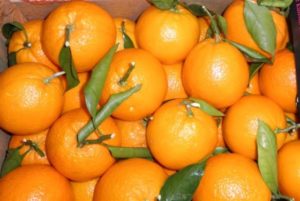
The yield of Oranges:
Commences from the 5th year with about 50 fruits per tree and stabilizes in the 8th year. Average production is about 700-800 fruits per tree after stabilization. Sweet Orange: Commences from the 5th year with 40-50 fruits per tree & stabilizes around the 8th year. Average production is about 500-600 fruits per tree after stabilization.
Post Harvesting activity:
Following are the post-harvesting activity involved in orange farming :
1) Grading 2) Storage 3) Packing 4) Transportation 5) Marketing.
That’s all folks about the farming of oranges, planting techniques and orange plant care. Keep growing fruits!.
In case if you miss this: How to Grow Tomatoes from Seeds.
- Types of Pesticides Used in Agriculture: A Beginner’s Guide
- Economical Aquaculture: A Guide to Low-Budget Fish Farming
- 15 Common Planting Errors That Can Doom Your Fruit Trees
- How to Make Houseplants Bushy: Effective Tips and Ideas
- Innovative Strategies for Boosting Coconut Pollination and Yield
- Pollination Strategies for Maximum Pumpkin Yield
- The Complete Guide to Chicken Fattening: Strategies for Maximum Growth
- Natural Solutions for Tulip Problems: 100% Effective Remedies for Leaf and Bulb-Related Issues
- Revolutionizing Citrus Preservation: Towards a Healthier, Greener Future
- Natural Solutions for Peony Leaf and Flower Problems: 100% Effective Remedies
- Maximizing Profits with Avocado Contract Farming in India: A Comprehensive Guide
- Natural Solutions for Hydrangea Problems: 100% Effective Remedies for Leaf and Flowers
- The Ultimate Guide to Choosing the Perfect Foliage Friend: Bringing Life Indoors
- From Sunlight to Sustainability: 15 Ways to Use Solar Technology in Agriculture
- The Ultimate Guide to Dong Tao Chicken: Exploring from History to Raising
- The Eco-Friendly Makeover: How to Convert Your Unused Swimming Pool into a Fish Pond
- Mastering the Art of Delaware Chicken Farming: Essentials for Healthy Backyard Flocks
- 20 Best Homemade Fertilizers for Money Plant: DIY Recipes and Application Methods
- How to Craft a Comprehensive Free-Range Chicken Farming Business Plan
- Brighten Your Flock: Raising Easter Egger Chickens for Beauty and Bounty
- How to Optimize Your Poultry Egg Farm Business Plan with These Strategies
- Subsidy for Spirulina Cultivation: How Indian Government Schemes Encouraging Spirulina Farmers
- Ultimate Guide to Raising Dominique Chickens: Breeding, Feeding, Egg-Production, and Care
- Mastering the Art of Raising Jersey Giant Chickens: Care, Feeding, and More
- Ultimate Guide to Raising Legbar Chickens: Breeding, Farming Practices, Diet, Egg-Production
- How to Raise Welsummer Chickens: A Comprehensive Guide for Beginners
- How to Protect Indoor Plants in Winter: A Comprehensive Guide
I Want To Receive Training In Orange Farming. I Want To Purchase Lemon and Orange Saplings. please Advice
good information, in future would like to get involve in valencia orange farming, and sell the oranges.
Super article. Lucid. Succinct. Accurate. Brief. Clear.
Best wishes
Good information.
Am planning to initiate Orange farming in Nagpur belt very shortly and would like to receive advise on this.
Can someone guide?
Regards,